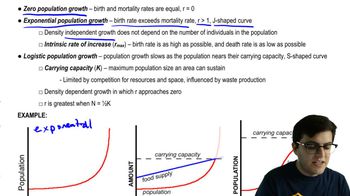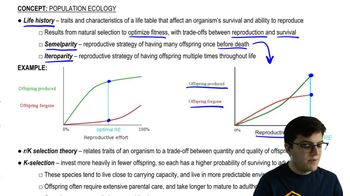- 1. Introduction to Biology2h 40m
- 2. Chemistry3h 40m
- 3. Water1h 26m
- 4. Biomolecules2h 23m
- 5. Cell Components2h 26m
- 6. The Membrane2h 31m
- 7. Energy and Metabolism2h 0m
- 8. Respiration2h 40m
- 9. Photosynthesis2h 49m
- 10. Cell Signaling59m
- 11. Cell Division2h 47m
- 12. Meiosis2h 0m
- 13. Mendelian Genetics4h 41m
- Introduction to Mendel's Experiments7m
- Genotype vs. Phenotype17m
- Punnett Squares13m
- Mendel's Experiments26m
- Mendel's Laws18m
- Monohybrid Crosses16m
- Test Crosses14m
- Dihybrid Crosses20m
- Punnett Square Probability26m
- Incomplete Dominance vs. Codominance20m
- Epistasis7m
- Non-Mendelian Genetics12m
- Pedigrees6m
- Autosomal Inheritance21m
- Sex-Linked Inheritance43m
- X-Inactivation9m
- 14. DNA Synthesis2h 27m
- 15. Gene Expression3h 20m
- 16. Regulation of Expression3h 31m
- Introduction to Regulation of Gene Expression13m
- Prokaryotic Gene Regulation via Operons27m
- The Lac Operon21m
- Glucose's Impact on Lac Operon25m
- The Trp Operon20m
- Review of the Lac Operon & Trp Operon11m
- Introduction to Eukaryotic Gene Regulation9m
- Eukaryotic Chromatin Modifications16m
- Eukaryotic Transcriptional Control22m
- Eukaryotic Post-Transcriptional Regulation28m
- Eukaryotic Post-Translational Regulation13m
- 17. Viruses37m
- 18. Biotechnology2h 58m
- 19. Genomics17m
- 20. Development1h 5m
- 21. Evolution3h 1m
- 22. Evolution of Populations3h 52m
- 23. Speciation1h 37m
- 24. History of Life on Earth2h 6m
- 25. Phylogeny2h 31m
- 26. Prokaryotes4h 59m
- 27. Protists1h 12m
- 28. Plants1h 22m
- 29. Fungi36m
- 30. Overview of Animals34m
- 31. Invertebrates1h 2m
- 32. Vertebrates50m
- 33. Plant Anatomy1h 3m
- 34. Vascular Plant Transport2m
- 35. Soil37m
- 36. Plant Reproduction47m
- 37. Plant Sensation and Response1h 9m
- 38. Animal Form and Function1h 19m
- 39. Digestive System10m
- 40. Circulatory System1h 57m
- 41. Immune System1h 12m
- 42. Osmoregulation and Excretion50m
- 43. Endocrine System4m
- 44. Animal Reproduction2m
- 45. Nervous System55m
- 46. Sensory Systems46m
- 47. Muscle Systems23m
- 48. Ecology3h 11m
- Introduction to Ecology20m
- Biogeography14m
- Earth's Climate Patterns50m
- Introduction to Terrestrial Biomes10m
- Terrestrial Biomes: Near Equator13m
- Terrestrial Biomes: Temperate Regions10m
- Terrestrial Biomes: Northern Regions15m
- Introduction to Aquatic Biomes27m
- Freshwater Aquatic Biomes14m
- Marine Aquatic Biomes13m
- 49. Animal Behavior28m
- 50. Population Ecology3h 41m
- Introduction to Population Ecology28m
- Population Sampling Methods23m
- Life History12m
- Population Demography17m
- Factors Limiting Population Growth14m
- Introduction to Population Growth Models22m
- Linear Population Growth6m
- Exponential Population Growth29m
- Logistic Population Growth32m
- r/K Selection10m
- The Human Population22m
- 51. Community Ecology2h 46m
- Introduction to Community Ecology2m
- Introduction to Community Interactions9m
- Community Interactions: Competition (-/-)38m
- Community Interactions: Exploitation (+/-)23m
- Community Interactions: Mutualism (+/+) & Commensalism (+/0)9m
- Community Structure35m
- Community Dynamics26m
- Geographic Impact on Communities21m
- 52. Ecosystems2h 36m
- 53. Conservation Biology24m
50. Population Ecology
Introduction to Population Ecology
Problem 11a
Textbook Question
What is survivorship? What does a survivorship curve show? Explain what the three survivorship curves tell us about humans, squirrels, and clams.
 Verified step by step guidance
Verified step by step guidance1
Survivorship refers to the percentage of a population that survives to a particular age. It is often represented graphically through survivorship curves, which plot the number of individuals surviving at each age against time.
A survivorship curve shows the pattern of survival over the lifespan of a species. It helps in understanding the mortality rate and survival probability of different species at various stages of their life.
There are three types of survivorship curves: Type I, Type II, and Type III. Type I curves depict species that have high survival rates in the early and middle life, but experience a rapid decline in survival in later life stages. This is typical of humans who tend to live long lives but experience higher mortality rates as they age.
Type II curves represent species that have a relatively constant mortality rate throughout their life. This is seen in organisms like squirrels, where the chance of surviving remains consistent whether they are young or old.
Type III curves show species that have high mortality rates early in life, with few individuals surviving to adulthood. However, those that do survive to adulthood tend to live longer. This pattern is common in species like clams, where a large number of offspring are produced but very few survive to maturity.
Recommended similar problem, with video answer:
 Verified Solution
Verified SolutionThis video solution was recommended by our tutors as helpful for the problem above
Video duration:
2mPlay a video:
Was this helpful?
Key Concepts
Here are the essential concepts you must grasp in order to answer the question correctly.
Survivorship
Survivorship refers to the proportion of individuals in a population that survive to a certain age. It is a key concept in ecology and demography, helping to understand population dynamics and life history strategies. Survivorship is often influenced by factors such as environmental conditions, predation, and reproductive strategies.
Recommended video:
Guided course

Survivorship
Survivorship Curve
A survivorship curve is a graphical representation that shows the number of individuals surviving at each age for a given species. There are three main types of survivorship curves: Type I (high survival in early and middle life, with a rapid decline in old age), Type II (constant mortality rate throughout life), and Type III (high mortality in early life, with survivors living longer). These curves provide insights into the life history traits of different species.
Recommended video:
Guided course

Survivorship Curves
Types of Survivorship Curves
The three types of survivorship curves illustrate different reproductive strategies and survival patterns among species. Type I, exemplified by humans, shows high survival rates in early and middle life. Type II, seen in squirrels, indicates a steady decline in survival regardless of age. Type III, characteristic of clams, reveals high mortality in early stages, with few surviving to adulthood, highlighting the trade-offs in reproductive strategies across species.
Recommended video:
Guided course

Survivorship Curves

 1:17m
1:17mWatch next
Master Population Ecology with a bite sized video explanation from Jason Amores Sumpter
Start learningRelated Videos
Related Practice


































































